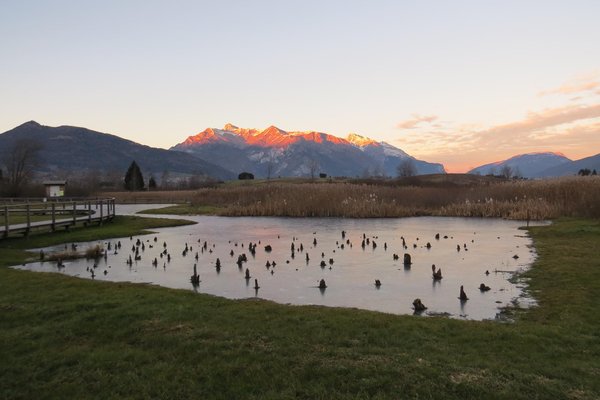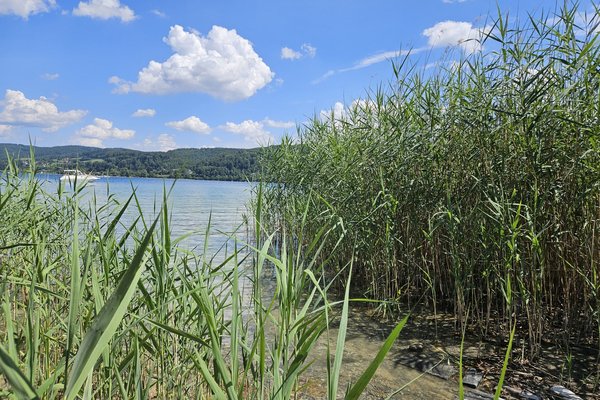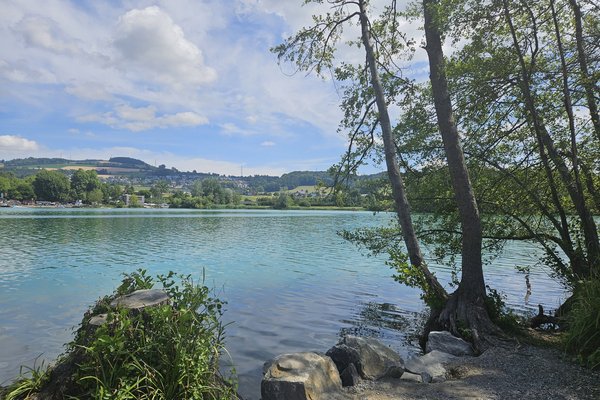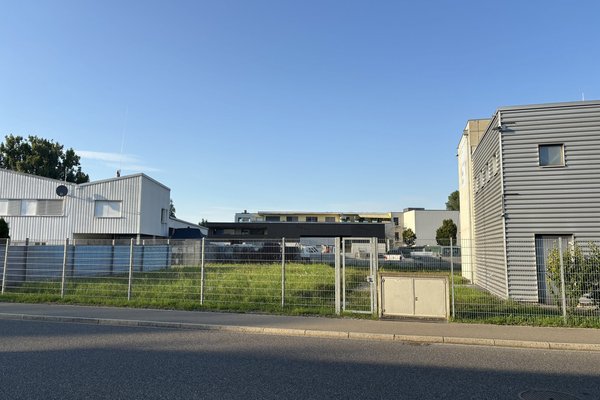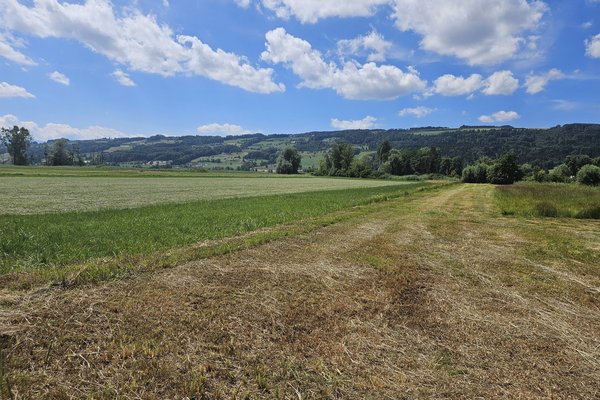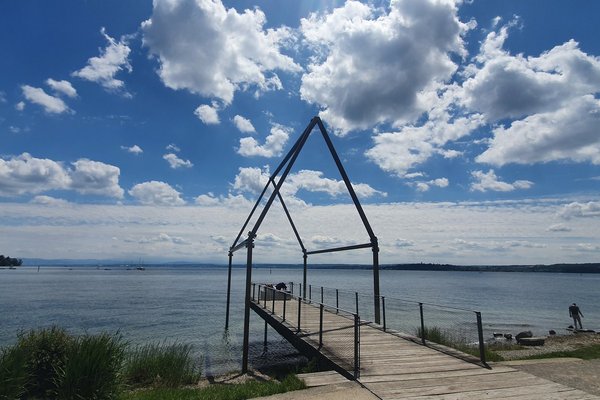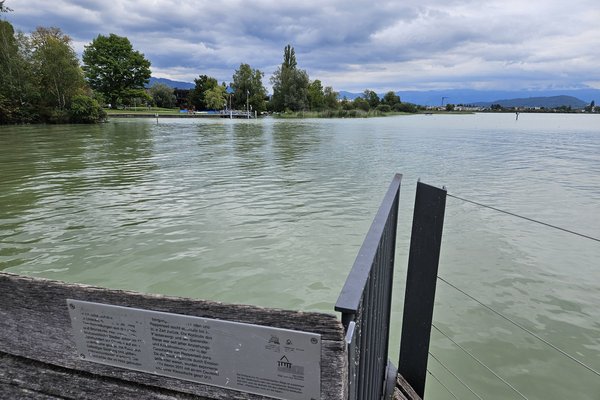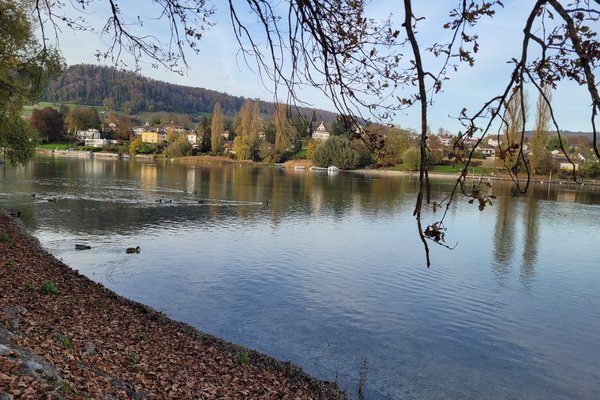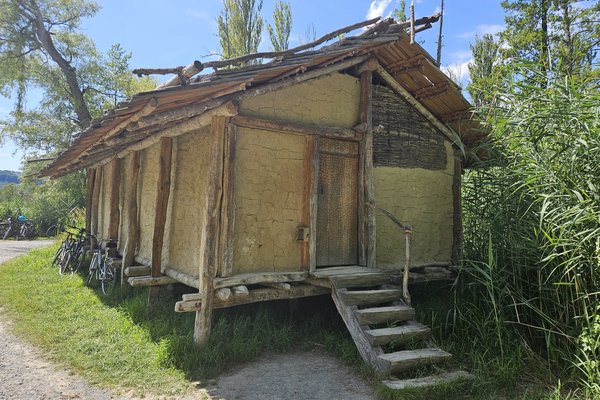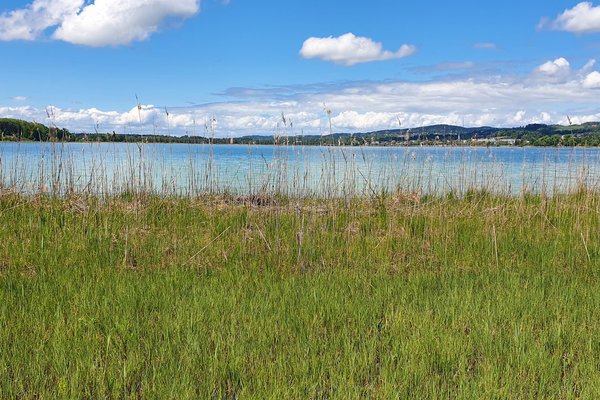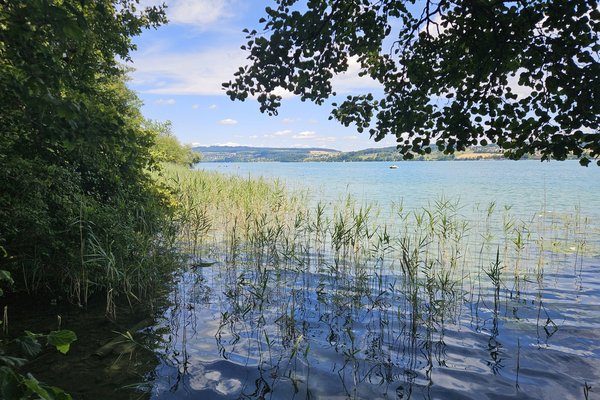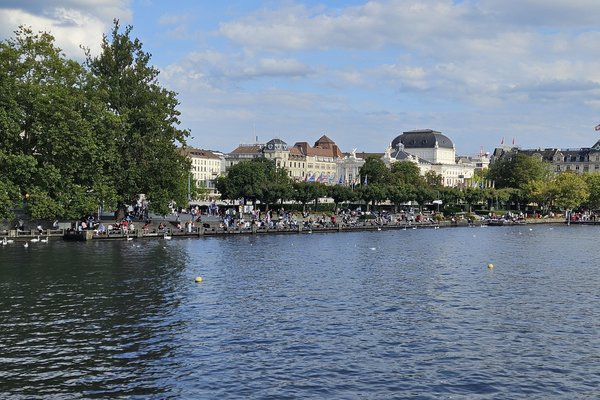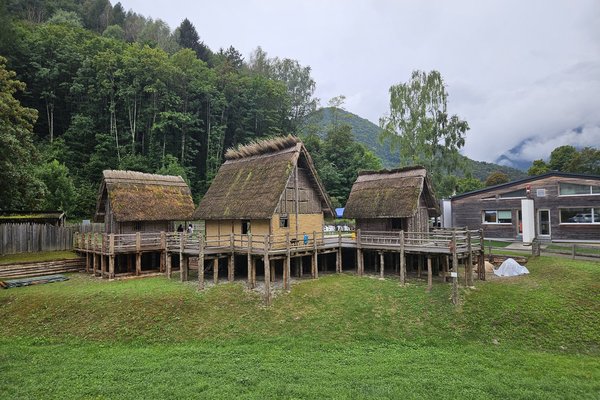Austria, France, Germany, Italy, Slovenia, Switzerland
Prehistoric Pile Dwellings
The Prehistoric Pile Dwellings around the Alps are the remains of prehistoric agrarian lake shore communities.
Rising water levels since prehistory led to the abandonment of these stilt house settlements. Covered by lake and river sediments, organic materials such as wooden structures have been preserved. Archeological findings further include the oldest textiles discovered in Europe, dugout canoes and wooden wheels. About 30 different cultural groups were responsible for creating these pile dwellings.
Community Perspective: only at very few of the 111 locations can original remains be seen, at the others, you will be staring “intently at the water trying to spot the merest hint of some buried rotten wood”. Molina di Ledro and Fiave in Italy are your best bets. Solivagant contemplates what a visit to the Pile Dwellings entails, and Hubert has visited multiple locations.
Site Info
Official Information
- Full Name
- Prehistoric Pile Dwellings around the Alps (ID: 1363)
- Status
-
Inscribed 2011
Site history
History of Prehistoric Pile Dwellings
- 2011: Inscribed
- Inscribed
- Type
- Cultural
- Criteria
- iv
- v
Links
- UNESCO
- whc.unesco.org
- Official
-
- palafittes.org — International Pile Dwellings nomination
- Related
-
- culture.gouv.fr — Chalain and Clairvaux
- palafittes.at — About the Austrian sites
- weltkulturerbe-pfahlbauten.de — Informations on the German sites
All Links
UNESCO.org
- whc.unesco.org — whc.unesco.org/
Official Website
- palafittes.org — International Pile Dwellings nomination
Forum Discussion
- worldheritagesite.org — Visiting the Pile Dwellings
Related Resources
- culture.gouv.fr — Chalain and Clairvaux
- palafittes.at — About the Austrian sites
- weltkulturerbe-pfahlbauten.de — Informations on the German sites
News Article
- Jan. 20, 2019 sueddeutsche.de — Roseninsel: 5000 Jahre alten Pfahlbauten bedroht
- Nov. 1, 2017 phys.org — Three ways to preserve a Neolithic site
- Dec. 12, 2016 aargauerzeitung.ch — Remains of Hallwilersee Pile Dwellings to be covered by gravel
- Sept. 11, 2016 thetelegraphandargus.co.uk — First underwater excavation of a prehistoric settlement at Lake Viverone
- Sept. 1, 2015 zentralplus.ch — Luzerner Pile Dwellings decay fast
Community Information
- Community Category
- Archaeological site: Prehistoric
Travel Information
Serial Transnational Sites
Lyon Hotspot
Recent Connections
-
Rhine
About 7 of its locations can be conside…
-
Rose garden
Roseninsel (wiki de)
-
Historic climate change
"Criterion (v): ..The revealed archaeol…
Connections of Prehistoric Pile Dwellings
- Geography
-
-
Rhine
About 7 of its locations can be considered as 'along the Rhine', with the Insel Werd being in the middle of the river.
-
Notable lakes
several sites around the Lake Constance -
Alps
-
- Trivia
-
-
Serial sites with the greatest number of locations
111 separate locations
-
- History
-
-
Oldest Buildings
5000-500BC. The oldest are given as being from between 5000-4000BC. Visibility varies according to the site. That at Molina di Ladro in Italy, whose piles are visible above the water, dates to 2000BC - there may or may not be older examples visible -
Neolithic age
"The waterlogged conditions have preserved organic matter that contributes in an outstanding way to our understanding of significant changes in the Neolithic and Bronze Age history of Europe in general," (OUV) -
Archaeological 'Type Sites'
The Swiss site CH-ZH-03 at Horgen-Scheller gave its name to the Horgen culture. See pp 305/6 of the Nomination File and (link)See de.wikipedia.org
-
Historic climate change
"Criterion (v): ..The revealed archaeological evidence allows an unique understanding of the way these societies interacted with their environment, in response to new technologies, and also to the impact of climate change." (OUV)
-
Historical Food Remains
Besides stores of grain and waste from processing cereals, remnants of food have also been found on ceramic vessels in pile-dwelling sites; these include various types of stews, por- ridges and probably also baked goods. -
Bronze Age
Crit iv: "The waterlogged conditions have preserved organic matter that contributes in an outstanding way to our understanding of significant changes in the Neolithic and Bronze Age history of Europe" (OUV)
-
- Ecology
-
-
Peat
The dwellings in Fiavé are located in a peat bog
-
- Architecture
-
-
Wooden architecture
-
Rose garden
Roseninsel (wiki de)
-
- World Heritage Process
-
-
Serial Transnational Sites
6 countries -
Perfect Inscriptions
2011 -
Part of Cultural nomination rejected
The Nomination File shows that 156 sites were nominated but ICOMOS got this reduced to 111 by the nominating countries during the evaluation process and all of these were inscribed
-
- Human Activity
-
-
Textiles
the oldest textiles in Europe dating to 3,000 BC come from the pile dwellings (AB ev)
-
- Constructions
-
-
Built on Stilts
"This serial property of 111 small individual sites encompasses the remains of prehistoric pile-dwelling (or stilt house) settlements in and around the Alps built from around 5000 to 500 B.C. on the edges of lakes, rivers or wetlands." (UNESCO description)
-
- WHS on Other Lists
-
-
World Biosphere Reserves
Ledro Alps and Judicaria Biosphere Reserve: "The area also includes two pile-dwelling settlements around Lake Ledro and Lake Carera-Fiavè", and Lac du Bourget (2025)
See www.unesco.org
-
Most beautiful villages
Ledro is among the Bandiere arancioni ('orange flags') by the Touring Club Italiano -
Ramsar Wetlands
Rives du Lac Léman + Lac du Bourget - Marais de Chautagne + Bodensee : Wollmatinger Ried - Giehrenmoos & Mindelsee + Rive sud du lac de Neuchâtel
-
- Timeline
- WHS Hotspots
-
-
Linz Hotspot
-
Zürich Hotspot
-
Lyon Hotspot
4 locations around Lac du Bourget, near Aix-les-Bains (1h10 by train) -
Bavaria hotspot
-
Stuttgart Hotspot
-
Lombardy hotspot
-
Jura Swiss Alps hotspot
-
- Science and Technology
-
-
Experimental Archaeology
See exarc.net
-
Underwater Archaeology
Almost all of the dwellings are completely or largely underwater
-
News
- sueddeutsche.de 01/20/2019
- Roseninsel: 5000 Jahre alten Pfahl…
- phys.org 11/01/2017
- Three ways to preserve a Neolithic…
- aargauerzeitung.ch 12/12/2016
- Remains of Hallwilersee Pile Dwell…
Recent Visitors
Visitors of Prehistoric Pile Dwellings
- Adam Hancock
- Adrian Turtschi
- Afshin Iranpour
- Aitia
- Alberto Rodriguez Gutierrez
- Alexander Barabanov
- Alexander Lehmann
- Alex Baranda
- alicemears
- Aljaz
- A. Mehmet Haksever
- Ammon Watkins
- AmyAbroad
- Ana Lozano
- Antonio J.
- Argo
- Aspasia
- Astraftis
- a.thum
- Atila Ege
- AYB
- BaziFettehenne
- Bernard Joseph Esposo Guerrero
- Bill Maurmann
- Bin
- Birgitte Sørensen
- Bodil Ankerly
- Bram de Bruin
- Brendan Carroll
- Bropyk
- Can SARICA
- Carlos Sotelo
- Caspar
- Cezar Grozavu
- Cheryl
- Christian Wagner
- Christine
- christof
- Christoph
- Christravelblog
- Claire Bradshaw
- ClaraHH
- Clyde
- Cobaltrage
- Colossus
- Coppi
- Cristina Erba
- Csaba Nováczky
- ctravel
- CugelVance
- Cyberczar
- Daniela Hohmann
- Daniel Chazad
- Daniel Gabi
- Dan Pettigrew
- David Berlanda
- Dimitar Krastev
- Dirk-pieter
- Dolemite92
- Dorejd
- Dr. Caligari
- Dwight Zehuan Xiao
- Echwel
- Elaine McArdle
- Elia Vettorato
- Elisabeth Fransisca Situmorang
- Els Slots
- erdsaumnaht
- Erik G
- Erik Jelinek
- Errol Neo
- Eva Kisgyorgy
- Evgenii
- fabi-ddorf
- Fam39
- Fan Yibo
- Farinelli
- Federico P.
- Feldhase
- Femke Roos
- FK
- Flexiear
- Frederik Dawson
- FS
- Gary Arndt
- George Gdanski
- GeorgeIng61
- GerhardM
- HaraldOest
- Harald T.
- Harry Mitsidis
- Hasco
- henrik_hannfors
- heywhatever2
- Hubert
- Hurrvinek
- Ian Cade
- ih0000
- Ivan Rucek
- Jakob F.
- Jana and Matt
- Janina Lehmann
- Janos
- Jan-Willem
- Jan Zimmermann
- Jarek Pokrzywnicki
- Jasam
- Javier Coro
- Jawnbeary
- Jay T
- Jean Lecaillon
- Jeanne OGrady
- Jeffrey Chai
- Jens
- Jesse S 2010
- Jezza
- JobStopar
- Joel on the Road
- John Smaranda
- Jonas Hagung
- Jonas Kremer
- Jon Eshuijs
- Joyce van Soest
- KarenBMoore
- Karito Vies
- Kasia M.
- Kbecq
- KentishTownRocks
- Kerékgyártó
- Klaus Freisinger
- Knut
- Kurt Lauer
- La Concy
- Lara Adler
- Laurine
- LaVale
- lichia
- Lisu Marian
- Lithobates
- ljowers
- Loic Pedras
- Luboang
- Lucio
- Luis Filipe Gaspar
- Maciej Gil
- Małgosia Łupicka
- Manuelfunk
- MarcoB_0
- marc Rouserez
- Martin
- Martina Rúčková
- Matejicek
- Mateusz
- Matthewsharris
- MatusBeber
- Max
- MaxHeAnouBen
- MaYumin
- MH
- Michael Novins
- michaelsballard
- MichaelStro
- Michael Turtle
- Mihai Dascalu
- Mikko
- Mikko Syrjä
- Miloš Tašković
- Mohboh
- MoPython
- Mstrebl1990
- nan
- Nasebaer
- natlefebvre@hotmail.
- Nihal Ege
- Nolan B.
- PabloNorte
- Paola Laura
- Patrik
- Paul Schofield
- Peltzi
- PeterH
- Peter Lööv
- Petteri
- Philipp Leu
- Philipp Peterer
- Piotr Wasil
- Porcho
- Purrfect
- Rafał Kałczuga
- Ralf Regele
- Ralf Rotheimer
- Randi Thomsen
- Reiseblitz
- Remigiusz
- Riccardo Quaranta
- Rick Ohm
- RobRos
- Rodinia
- Roel Sterken
- Roger Ourset
- Roman Bruehwiler
- Roman Raab
- Rudegirl
- Sabrina Liebehentschel
- Samy G
- sandersx2
- Schnitzel
- scubarrie
- Sebasfhb
- serghei.belous
- Sergio Arjona
- Shandos Cleaver
- Shijie ZHU
- shoaibmnagi
- Simonh
- SirLoydd
- Solivagant
- Stanislaw Warwas
- Stefan A. Michelfeit
- stephanvermeulen
- Stijn
- Svein Elias
- Szucs Tamas
- Tamara Ratz
- Taotao Chen
- Tarquinio_Superbo
- Tcchang0825
- Thomas Buechler
- Thomas Harold Watson
- Thomas van der Walt
- Thorben
- Tim Allen
- Tom Flaten
- tommasorossotti
- tony0001
- Traveling Girl
- triath
- Truls Brekke
- Tschibi
- Tsunami
- usagi1974
- ValiaVeweth
- Vanessa Buechler
- VB73
- VLabhard
- WalGra
- WILLIAM RICH
- Wojciech Fedoruk
- Wo_ko
- Xiquinho Silva
- YaroMir
- Yevhen Ivanovych
- Zach
- Zizmondka
- Złoty Tłok Czesław
- Zoë Sheng
- Zos M
- Александар Стојиљковић
Community Reviews
Show full reviews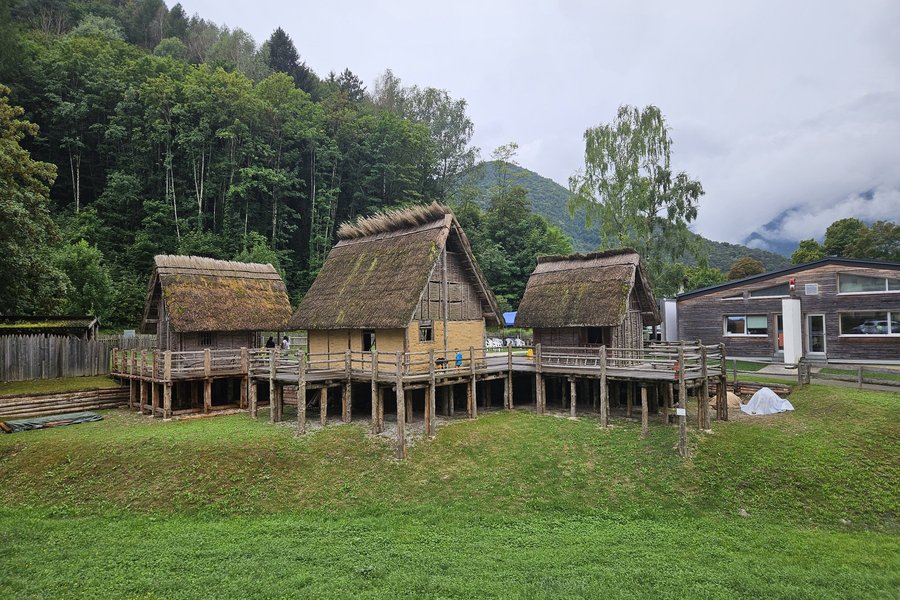
The Museo delle Palafitte del Lago di Ledro (Museum of Prehistoric Pile Dwellings) is a fascinating journey into a world over 4,000 years old. Located on the shores of the stunning Lake Ledro, this museum offers a unique and engaging experience that's well worth a visit.
What sets this museum apart is its incredible location. You can walk around the reconstructions of the pile dwellings, giving you a sense of what life was like in the Bronze Age. The setting itself is beautiful, making it feel less like a stuffy museum and more like a historical park. The detail in the reconstructed huts is impressive, and you can really imagine the daily lives of the people who once lived here.
Inside the main museum building, the exhibits are thoughtfully curated. They showcase a collection of tools, pottery, and other artifacts found. I particularly enjoyed the clear explanations, which bring the ancient history to life. It's easy to follow the story of the settlement and understand the significance of the objects on display.
Keep reading 0 commentsMoPython
Pile Dwellings on the lake – that must at least be a beautiful place!
Prehistoric Pile Dwellings (Inscribed)
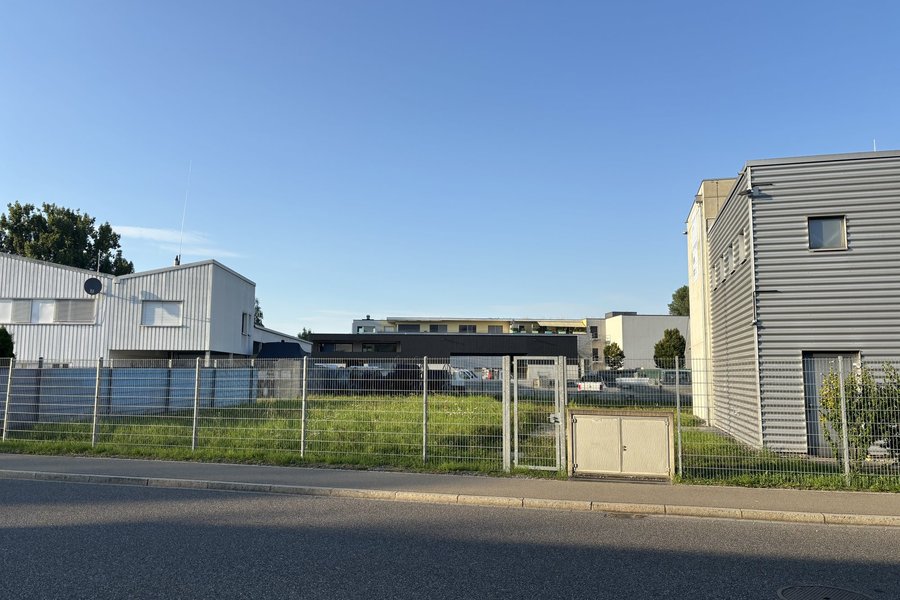
I am Swiss. Switzerland has 13 WHS and 1 TWHS, all of which I have seen for some time now. But in Switzerland, and only here, I have another goal: I want to have seen all the locations!
Nine of these 14 are easy, as there is only one location for each. Then there are the equally easy Le Corbusier and Beech Forests (two each in Switzerland), La Chaux-de-Fonds/Le Locle (two) and Bellinzona (three). Of these 13 (T)WHS sites, I only have one Beech Forest left to visit.
And then there are the Pile Dwellings...Of the total 111 locations, 56 are in Switzerland!
So I was once again on my way to a pile dwelling settlement, this time in Arbon on beautiful Lake Constance. My OUV expectations were not very high, as experience has shown that there is not really much to see at pile dwellings. But pile dwellings on the lake – that must at least be a beautiful place, one might think so lightly.
One positive thing about Arbon and its pile dwelling settlement can be said: it is easy to reach. If you come from the motorway, the main road leads right through the core zone! I parked on the side of this road and took the photo above, which shows roughly 80% of the core zone. In addition to the main road, the core zone contains two sports shops and several unidentifiable factories. Lake view? There isn't one; the lake is about 500 metres …
Keep reading 4 comments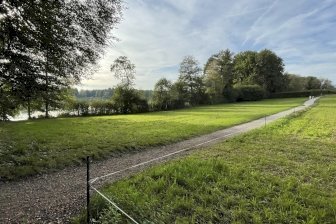
Burgäschisee Ost, October 2023
The Burgäschisee Ost-site consists of a 75x40 meter (0.3 ha) piece of meadow on the south-eastern shore of tiny lake Burgäschi, a pleasant 20-minute walk away through the rolling hills of Swiss Mittelland from the eponymous village of Aeschi, from where very regular buses plow the route from Solothurn to Herzogenbuchsee – both hubs on the Swiss rail network (the reason for the different spelling of Aeschi vs. Burgäschi is not totally clear to me).
According to the Internet, the settlement was discovered in 1943 after a lowering of the lake level and excavated in 1944/45 with the help of interned prisoners of war. The first phase of the Burgäschisee Ost site is attributed to the Egolzwil culture, the main phase belonging to the classical Cortaillod period and dating to around 3830 BC. Further excavations were done in 2015-2017.
The site is unmarked, and there are certainly no visible remains of any settlement. Note that the lowering of the lake level explains why the site is now fully onshore.
On the photo, the core site is on the left side of the little road, bordering the lake; reeds and some small trees grow on the lakeshore, making access to the water from the core zone a bit difficult; there are openings, however, on both the southern and northern end a few meters outside the core perimeter.
Some 200 meters north of the core site is Restaurant Seeblick, along with a nice …
Keep reading 0 comments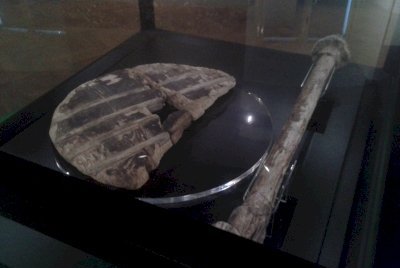
Maybe I am too bold to claim the ticking off the pile dwelling sites.
Last week (in October 2021), I visited Ljubljana and I went by the Slovenian components in the Marshland nearby Ljubljana. There is nothing special to see at the site, and I was too shy to force my colleagues to explore it more in detail. However, I visited the City Museum of Ljubljana in the city center, which is located in the buffer zone of the Plečnik´s WHS. There is one room dedicated to the pile dwellings and related archeological findings around Ljubljana and the focal piece of the room as well as the entire museum is "Wheel of global significance" (PHOTO), which is mentioned also in the nomination text.
Here is the text written on the banner:
"Wheel of global significance:
The wooden wheel with an axle, as many as 5,200 years old, is a special treasure of the world´s cultural heritage, both because of its age and its technological perfection. The wheel, possibly a part of a two-wheeled cart, is composed of two ash wood plates joined with four oak wood pins. Tha axle is made from one piece of oak wood, its rectangular ends fitting into the wheel hub. The selection of wood, the accommodation made for wood expansion and shrinking as well as the manner of fixing and joining suggested that the wheel was made by an expert who was knowledgeable about wood varieties.
The wheel with the …
Keep reading 0 comments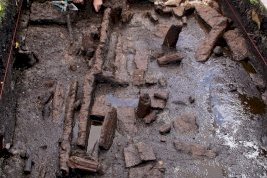
My first visit to these prehistoric pile dwellings was Fiave and Molina di Ledro/Italy in 2011 (see my review below). And to say it right away, these are the best (or basically the only) sites to see original remains. Usually, all the remains are under water or in the bog, otherwise none of it would have survived for thousands of years. And often the sites are covered with geotextile and gravel to protect against erosion and mechanical damage. Thus you have to rely on the preserved finds in museums and on replicas of the dwellings and settlements to understand what this WHS is all about. However, the preservation conditions under oxygen exclusion are so good that organic material, food and textiles, has also been preserved. Therefore, a lot is known about the living conditions of these early agrarian communities.
Over the past ten years, I have visited several of the pile dwelling sites, mainly in the eastern part of the Alps. Here is my summary of what to expect from these sites.
My personal pile dwelling highlight was Olzreute-Enzisholz in Germany. In 2016, an archaeological excavation was carried out in Olzreute, which was also open to visitors. In Olzreute, the remains of the dwellings are half a metre deep in the peat bog, and visitors could watch the researchers uncovering the wooden floors and collapsed walls (photo). The work of the scientific laboratories was also demonstrated and explained on site: the determination of plant and bone remains, …
Keep reading 0 comments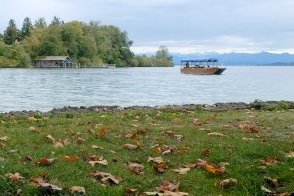
The day we visited Augsburg and Roseninsel might be the least impressive leg of my World Heritage Site hunting in Europe in 2019. Augsburg kept me wondering how the monuments ever made it to the list, and Roseninsel further left me inconclusive: Did I see the site properly? I am not sure if I managed to see some remains or not, but I was hoping and I wanted to believe that I somehow managed to sight even just a piece of it from the easternmost side of the island. The ferryman never failed to mention it and the signage around even mark the areas where the remains are supposed to lie (demarcated by the floaters in the vicinity). As far as ticking the site off, the island itself is already part of the core zone, in fact it is the heart of it! However, as far as being contented and having expectations met, it is entirely a different story.
If there was any consolation, however, lake Starnberg is truly marvelous. It is a place I would not mind returning to in the future. We were very lucky that day to have a nice weather, so Zugspitze and the other side of the lake were clearly visible. It was the second to the last day of the boat service to the island (as they close for the winter), and we went there at around 3pm. There were only about 7 of us on the boat, hence a lovely, non-hectic experience …
Keep reading 0 comments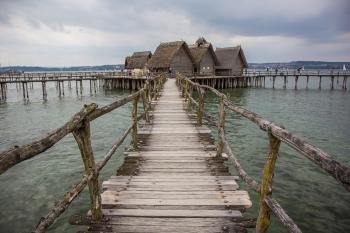
On the edge of Lake Constance, in the town of Unteruhldingen, experts have reconstructed a small community of these ancient pile dwellings. Although it is artificial in the sense that the structures are not original, everything has been put together exactly the way it would have been thousands of years ago. The museum is run by underwater archaeologists and cultural historians to ensure the accuracy of everything.
What is particularly interesting is the way the huts are displayed these days as interconnected. Although the construction is quite rudimentary, there is an advanced sense of community in the design. The dwellings are built in clusters and are connected with elevated walkways. There is even a protective wall built in the water around one of the groups of buildings to create a small protected harbour.
The museum has also incorporated exhibitions, displays and reconstructions within the dwellings to help illustrate the life of the original inhabitants. It is useful and informative but is a reminder that these structures are not strictly a historic site themselves, just representative of the ones that were once scattered all across this region and are now marked only by their underwater foundations.
Keep reading 0 comments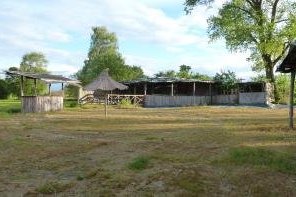
Pile Dwellings Part III
We find our protagonists strolling in the late afternoon sun across the road from the Pestenacker prehistoric museum
NS: "So on the map you printed out the WHS seems to be in the middle of those fields"
IC: "That must be it there, in those big agricultural looking sheds"
NS: "Maybe it is an archaeological dig"
IC: "Yeah it must be, perhaps we've accidentally hit the pile dwelling jackpot!"
NS: "Hmm... my sodden shoes would suggest otherwise"
IC: "Onwards then..."
NS: "I must admit it feels a little creepy, really like we shouldn't be here."
IC: "Is it the lack of signs and pathways, or in fact any tangible evidence of this not being a farm that make you think that."
NS: "Well these buildings could we reveal wondrous secrets"
Our protagonists walk around large shed like structure.
NS: "Erm..."
IC: "Well I don't think it is an archaeological dig."
NS: "Is that...? Is that a beach hut?"
IC: "Yep I think so, that would also explain the sand on the floor I guess."
NS: "I think that was once a swimming pool"
IC: "Where?"
NS: "Erm that sort of ditch in front of the beach hut."
IC: "Oh"
NS: "Erm..."
IC: "Have we stumbled into a derelict German rave?"
NS: "This discarded hat behind the bar would indicate yes."
IC: "And yep that must be the DJ booth."
NS: "Hmm."
Our protagonists stroll around the wooden shacks and weed …
Keep reading 0 comments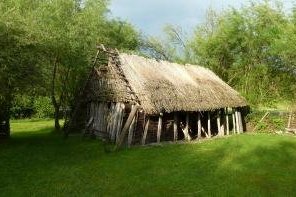
Pile Dwellings Part II
Venice, Angkor, Yellowstone, Pasternacker prehistoric museum; hunting world heritage sites has taken me to some of the most spectacular places on earth, and also to Pestenacker prehistoric museum. It is an unfair comparison but they are all on the list together and I'm sure the local community at Pestenacker have immense pride in their world heritage certificate and so they should. The little museum (closed during our visit) is complemented by a slightly tired looking reconstruction of a pile dwelling. Next to this is a small stream which bisects the field under which the remains lay buried. There is precisely nothing of any note to see in the field, trust me we looked hard for any hint of rotten wood.
So after 5 minutes we were heading off across the road to see the second site listed outside this Bavarian hamlet.
[Site 0: Experience 5]
Keep reading 0 comments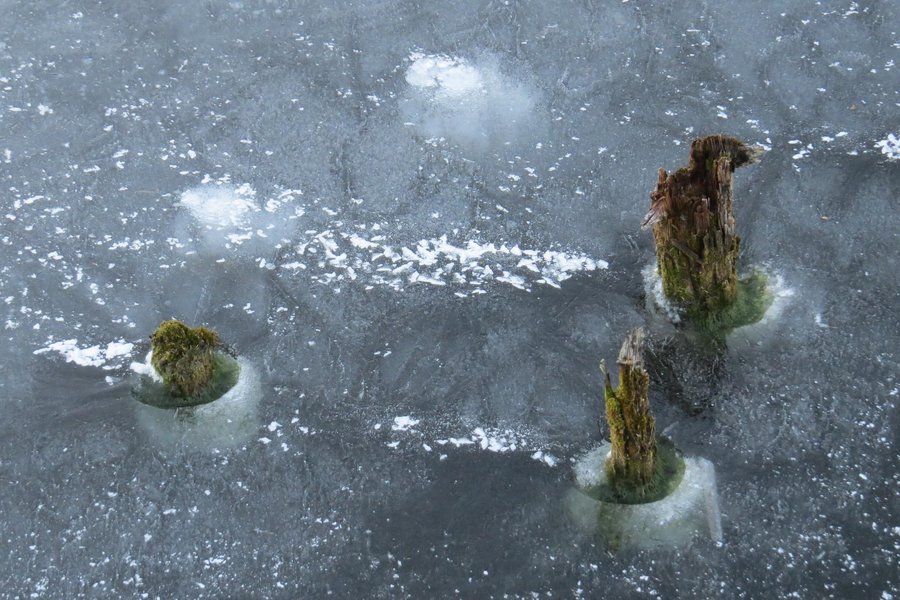
One of the best places to experience this somewhat unusual site is the small German town of Unteruhldingen on Lake Constance, not far from Friedrichshafen and Konstanz. It features a well-known open-air museum with reconstructed pile dwellings and an interesting exhibition. Of course, the museum itself is not part of the WHs, but there is probably no other place where the mysterious, prehistoric world of pile dwellers is so graphically illustrated. And there is an actual WH location near the town's port, maybe a 5-minute walk from the museum. You can only see the plaque on the shore, as the pile dwellings are underwater and also covered by a canvas to protect them from damage caused by weather or boats. Still, it is good enough to tick off the site. Unteruhldingen is next to the famous flower island of Mainau, and can be easily reached by ferry from Meersburg.
On a trip to Zurich, I checked out the 2 sites on Lake Zurich in the city centre, but couldn't find any sign. I also went to Rapperswil on the southern end of the lake and tried to find the sites there, but only found general signage, not specific pointers (but the area seemed perfect for pile dwellings, especially along the footbridge connecting the town with the island of Hurden).
Keep reading 0 comments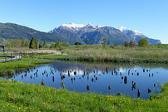
I visited this WHS in May 2014. I drove to Fiave’ in Trentino Alto Adige through mountain passes and winding roads. I was lucky to find perfect blue skies and sunny weather just a few days after snowfall, meaning that the mountain peaks were covered in snow. I was afraid that the pile dwelling remains were going to be underwater but this was not the case and I was very pleased. Set the GPS to the Hotel La Pineta which is just in front of the narrow unpaved road for pedestrians leading to the pile dwellings. The entrance is free and there are a few information boards give you a brief overview. In the town of Fiave’ there is the Pile Dwelling Museum which is worth visiting if you have some time. However, I very much prefer the Pfahlbaum Museum of Unteruhldigen near Lake Constance in Germany which is by far better and it also has replicas of pile dwellings next to the actual remains in Germany (now underwater!).
Keep reading 0 comments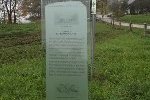
During a brief visit to Austria last year I managed to find a few more pile dwelling sites:
Attersee: On the lakefront at Seewaldchen there is a mock-up of a pile dwelling with descriptive signs. Opposite the railway station , beside the lake in Attersee village is a descriptive sign. At See am Mondsee there is a descriptive sign, and piles are visible beneath the water from the nearby bridge. I reached these sites by bus from Vocklabruck.
Keutschachersee: I found a descriptive sign at the eastern end of the lake, near the entrance to a recreation area. I caught a bus there from Klagenfurt.
Keep reading 0 comments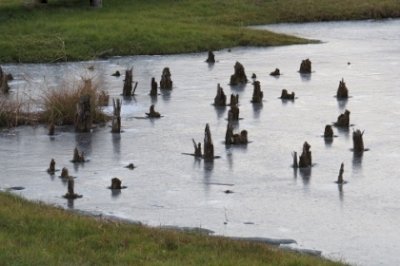
I think these elusive Pile Dwellings secretly were the main goal for my December trip to Northern Italy. The Fiavè location seemed a sure bet to see “something”, and when I searched around for opening hours I found out that the Pile Dwelling museum in Fiavè opens up in winter too (2-6 p.m.). So I fitted this area into my full-day itinerary around the Italian Alps, which lead me to no less than 3 new WHS.
Fiavè is a town about half an hour south of Lake Molveno (with a Dolomites view). It lies in a valley and is nice enough in its own right because of the vernacular Alpine architecture. However, I went straight to the Pile Dwelling Museum, located in the town center. The museum is new (or revamped because of the WHS designation?) - see the 2nd small picture for what it looks like. I had expected a small village museum with some pots and information panels. This is a modern museum, however, with ample use of audiovisual presentations. The exhibition focuses on the story of the pile dwellers around Fiavè (not the broader context), on how the archeological research developed, how the people lived etc. Quite a lot of objects belonging to the pile dwellers were found locally, such as baskets and hats woven out of reed. The entrance fee is 3.5 EUR. The museum has friendly staff and is worth at least half an hour. Displays are both in Italian and English.
What …
Keep reading 0 comments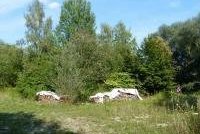
In the early days of the Forum on this Web site we had some discussions on what constituted “seeing” or “visiting” a WHS. Our trip to one of the Prehistoric Pile Dwellings provided a “reductio ad absurdam” example of the very concept of a “WHS Visit”!
When planning our “grand tour” of Germany in Aug/Sep 2013 I checked the locations of Germany’s Pile Dwellings and discovered that one, titled “Blaustein-Ehrenstein”, was situated a few kms NW of Ulm. Our chosen direct route wasn’t far away and Ulm was, in any case, a German city I quite wanted to visit – so off we set! Now, in all honesty, we didn’t expect much – the excavations would certainly have been back-filled but a picture on the Blaustein town Web site appeared to show an open area http://www.blaustein.de/de/freizeit-tourismus/steinzeitdorf-ehrenstein.html
This was confirmed by the brochure about the site which contained other photos of digs from the 1960s
http://www.blaustein.de/fileadmin/Dateien/Dateien/Steinzeitdorf_Ehrenstein_2012.pdf.
So hopefully we would gain a general view of the site and would surely find an explanatory board and a plaque indicating the site’s “world significance”!
At this point it is perhaps worth placing “Blaustein-Ehrenstein” in context within the overall inscription. The AB evaluation indicates that there are 937 known “pit dwelling” sites across Europe - 156 of these were nominated but ICOMOS asked whether this could be reduced and 111 were inscribed . This reduction must have happened quite late on as the Nomination file still contains the full 156. However the …
Keep reading 0 comments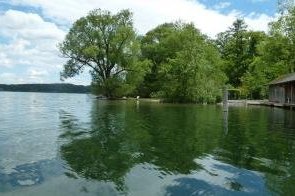
Part 1 of my visit to these pile Dwellings was a pleasant boat trip to Rosen Insel on Lake Starnberg.
From the station at Possenhoffen it is a quiet 40 minute walk along the forested lake shore which to my surprise reacquainted me with a familiar friend from a few years back: The Pilgrimage Route to Santiago. I arrived at the pontoon just as another couple rang a bell which summoned over the boat from Rosen Insel. The short crossing gave the driver just enough time to tell us a little about the island and say the key words "UNESCO-Welterbe". A quick lap of the rose gardens led me to the vantage point where I stared intently at the water trying to spot the merest hint of some buried rotten wood. I think I may have seen some in the right place, but to be honest it may have just been any old bit of rotten wood.
After a short look around the one room museum showing some finds I marched back to the pontoon, studiously avoiding the Royal Casino that everyone else was on the island to tour around and happy that I didn't have to explain I had taken 3 hour trip by train, boat and on foot just to not see some rotten wood.
I walked back to the station, stopping off to have a glass of wine before catching a train to meet up with my friend to continue the next part of our Pile …
Keep reading 0 comments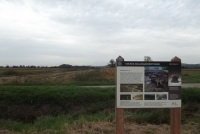
I knew that finding the locations of the WHS pile dwellings in a featureless wilderness like the Ljubljana Marsh would be difficult on my own. As anticipated there was no signed directions. I was fortunate to meet a local naturalist who knew the marshland well, and who took me to Ig to visit two sites.
I agree with Hubert that this site, like the German 'Limes' requires some imagination.
I also managed to find two locations in Italy, one by Lake Costa near Monselice, and another by Lake Frassino near Pescheria del Garda.
Keep reading 0 comments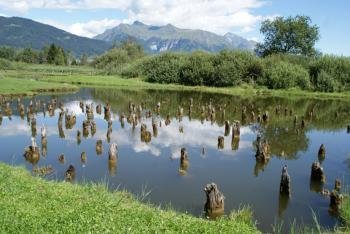
During a trip to the Dolomites, I took the opportunity to visit Molina di Ledro and Fiave. These sites are two of the rare places where original remains of the pile dwellings can be seen. In Molina di Ledro, at the shore of Lake Ledro, is a small museum and the reconstruction of a pile dwelling. From a footbridge you can see some piles in a small area near the shoreline. In Fiave, 35 km north of the Lake Ledro, is a small wetland with about 80-100 piles (photo). The site is one kilometre before Fiave on the left (coming from Lake Ledro). There is only a small signpost that can easily be overlooked. Both sites are located in a beautiful mountain landscape, but the remains themselves are not very impressive and do not tell much about what this WHS represents.
At least, I have seen my first pile dwellings and have an idea how the original remains look like. To learn more about it, one has to rely on museums and replications. In this respect, it reminds me of my experience with the Limes, the German part of the Frontiers of the Roman Empire, where also only a few original remains are visible.
Certainly, the pile dwellings are the oddest WHS that I've visited so far. I will not count the WHS as visited and I'm uncertain when I can tick it off. But my first visit made me curious to learn more about it.
Keep reading 0 comments
